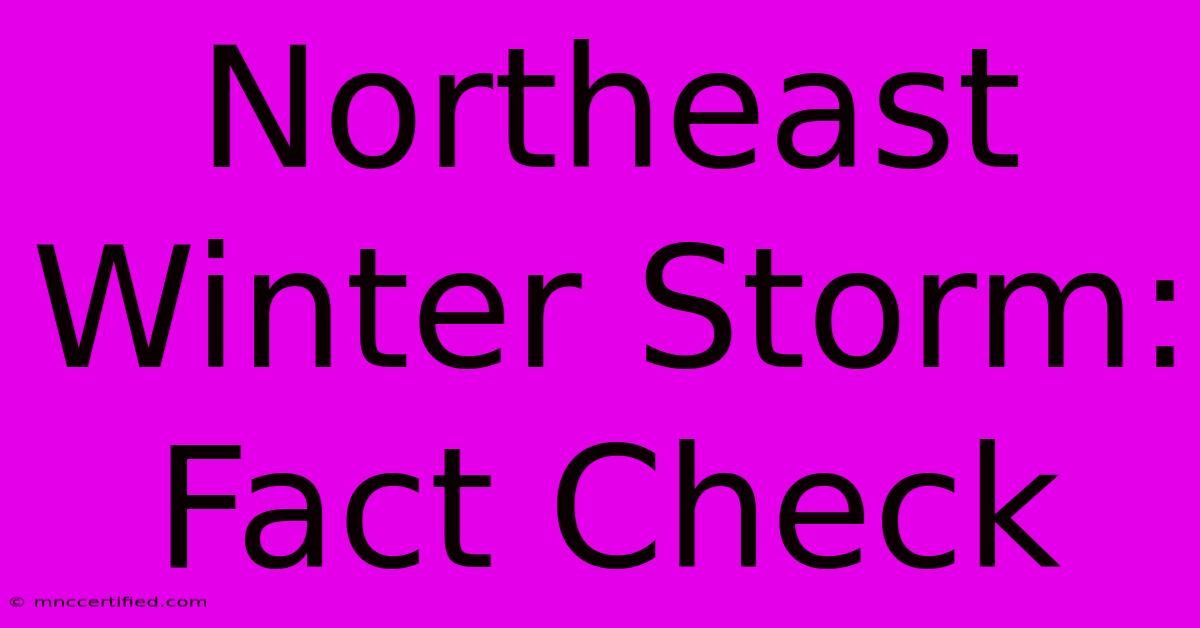Northeast Winter Storm: Fact Check

Table of Contents
Northeast Winter Storm: Fact Check – Separating Hype from Reality
The Northeast is no stranger to winter storms. Every year, forecasts of blizzard conditions, record-breaking snowfall, and crippling cold send ripples of anxiety through communities from Maine to Virginia. But how much of the pre-storm hype is actually fact? This article will delve into the common misconceptions surrounding Northeast winter storms and provide you with the tools to critically evaluate the information you encounter.
Debunking Common Myths About Northeast Winter Storms
Many factors contribute to the sometimes-exaggerated portrayal of winter storms in the Northeast. Sensationalist media headlines, social media misinformation, and even well-intentioned but inaccurate predictions can create a climate of fear and uncertainty. Let's address some of the most pervasive myths:
Myth 1: "This is the worst storm in decades!"
Fact Check: While some storms are undoubtedly severe, claiming every major winter storm is "the worst in decades" is a common hyperbole. While a storm might bring record snowfall to a specific location, the overall impact across the entire Northeast is rarely unprecedented. Look beyond the headline and examine the historical data for your specific region. Websites like the National Oceanic and Atmospheric Administration (NOAA) provide extensive historical weather data.
Myth 2: "All snowfall warnings mean school closures."
Fact Check: School closures are determined by local school districts based on a variety of factors including the intensity and duration of the storm, road conditions, and the district's own internal safety protocols. A snowfall warning doesn't automatically equate to school closures. Always check your local school district's website or social media for official announcements.
Myth 3: "The forecast is always accurate."
Fact Check: Weather forecasting, while incredibly advanced, is not an exact science. Models can and do change, particularly as a storm approaches. Pay attention to the forecast's confidence levels and be prepared for potential adjustments. Multiple sources are better than one—compare forecasts from different reputable organizations.
Myth 4: "Staying home is always the safest option."
Fact Check: While staying home is often the best course of action during a severe storm, there are exceptions. Essential workers like healthcare providers and emergency responders need to travel, even in hazardous conditions. If you must travel, prioritize safety: Check road conditions, ensure your vehicle is prepared for winter driving, and inform someone of your travel plans.
How to Verify Winter Storm Information
To avoid being swept up in the storm of misinformation, follow these steps:
- Consult Reliable Sources: Rely on official sources like the National Weather Service (NWS), NOAA, and your local news channels for accurate weather forecasts and warnings.
- Check Multiple Sources: Comparing forecasts from different reputable sources can help identify inconsistencies and gain a more comprehensive picture of the situation.
- Understand Warning Terminology: Familiarize yourself with weather warnings (watch, warning, advisory) and their respective meanings.
- Verify Social Media Posts: Be wary of unverified information circulating on social media. Cross-reference any claims with official sources.
- Prepare in Advance: Regardless of the storm's intensity, being prepared is always wise. Stock up on essential supplies, and develop a family emergency plan.
The Bottom Line: Stay Informed, Stay Safe
Northeast winter storms can be serious, but responsible preparation and reliable information are your best defenses against the chaos. By critically evaluating the information you receive and relying on credible sources, you can navigate the next winter storm with confidence and minimize unnecessary anxiety. Don't let the hype overshadow the facts. Stay informed, stay safe, and remember that preparedness is key.

Thank you for visiting our website wich cover about Northeast Winter Storm: Fact Check. We hope the information provided has been useful to you. Feel free to contact us if you have any questions or need further assistance. See you next time and dont miss to bookmark.
Featured Posts
-
Winter Storm Impacts Holiday Travel Plans
Nov 23, 2024
-
Best Bartender Insurance For 1 Day
Nov 23, 2024
-
Water Investments Michael Burry
Nov 23, 2024
-
How To Get A Texas Bonded Title
Nov 23, 2024
-
Public Health Alert Young Men Illness
Nov 23, 2024